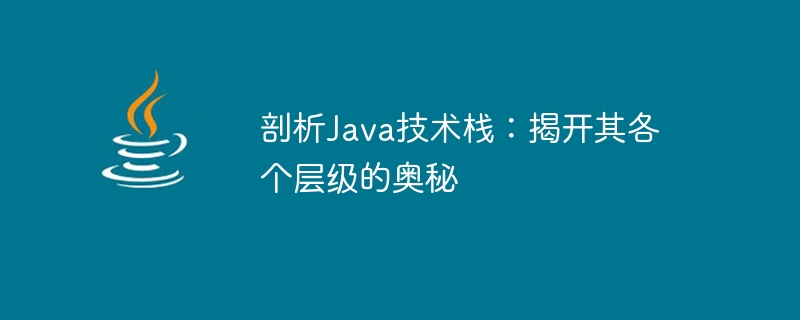

Analysis of the Java technology stack: Uncovering the mysteries of its various levels requires specific code examples
In recent years, Java technology has become increasingly widely used in the field of software development. As a cross-platform, object-oriented programming language, Java has become the first choice of many developers through its powerful functions and rich class libraries.
However, it is not easy to deeply understand and master the Java technology stack. This article will analyze each level of the Java technology stack from the underlying JVM to the upper-level framework, and reveal the secrets behind it.
First, let’s understand the core component of Java - the Java Virtual Machine (JVM). JVM is the bridge between Java applications and operating systems. It is responsible for translating Java bytecode files into machine code, and provides functions such as memory management and garbage collection. The following is a simple Java code example:
public class HelloWorld {
public static void main(String[] args) {
System.out.println("Hello, World!");
}
} In the above code, we define a HelloWorld class, which contains a main method. Through the System.out.println statement, we output a simple message on the console. When we compile and run this code, the JVM is responsible for loading the class, executing the bytecode, and printing "Hello, World!".
Next, we will delve into Java’s standard class library. The Java standard class library is the core part of the Java technology stack. It contains a large number of commonly used classes and interfaces, and provides a wealth of functions and tools. For example, the String class in the java.lang package is a common class for processing strings, and the ArrayList class in the java.util package Is a class that implements dynamic arrays.
The following is a code example using the ArrayList class:
import java.util.ArrayList;
public class ArrayListExample {
public static void main(String[] args) {
ArrayList<String> list = new ArrayList<>();
list.add("Apple");
list.add("Banana");
list.add("Orange");
System.out.println(list.size()); // 输出:3
System.out.println(list.get(1)); // 输出:Banana
}
}In the above code, we used the import statement to import the ArrayList class, and created an ArrayList object. Then, we added three elements to the list using the add method: Apple, Banana, and Orange. Finally, we use the size method to get the size of the list, and the get method to get the element at index 1 (i.e. the second element) in the list.
In addition to standard class libraries, the Java technology stack also includes many powerful open source frameworks. These frameworks provide developers with rich features and tools to accelerate the software development process. Among them, the Spring framework is one of the most popular frameworks in the Java technology stack.
The Spring framework simplifies application development and maintenance through features such as dependency injection (DI) and aspect-oriented programming (AOP). The following is a simple code example using the Spring framework:
import org.springframework.context.ApplicationContext;
import org.springframework.context.support.ClassPathXmlApplicationContext;
public class SpringExample {
public static void main(String[] args) {
ApplicationContext context = new ClassPathXmlApplicationContext("applicationContext.xml");
HelloWorldService service = (HelloWorldService) context.getBean("helloWorldService");
String message = service.getMessage();
System.out.println(message);
}
}In the above code, we use the Spring framework's ApplicationContext class to load the Spring configuration file (applicationContext.xml). Then, we obtain the Bean object named "helloWorldService" through the getBean method. Finally, we call the getMessage method of the object to get the message and output it to the console.
Through the above examples, we can see the relationship and usage between multiple levels of the Java technology stack. From JVM to standard class libraries to frameworks, the Java technology stack provides powerful tools and functions to help developers build high-performance, reliable applications.
To summarize, this article analyzes each level of the Java technology stack through specific code examples. From the underlying JVM to the upper-level standard class libraries and frameworks, these levels cooperate with each other to provide developers with a wealth of functions and tools. Whether you are learning Java or deepening the application of the Java technology stack, you need to understand and master the relationship between these levels and how to use them. I hope this article can be helpful to readers and allow everyone to better apply the Java technology stack.
The above is the detailed content of Anatomy of the Java technology stack: Uncovering the mysteries of its various layers. For more information, please follow other related articles on the PHP Chinese website!
